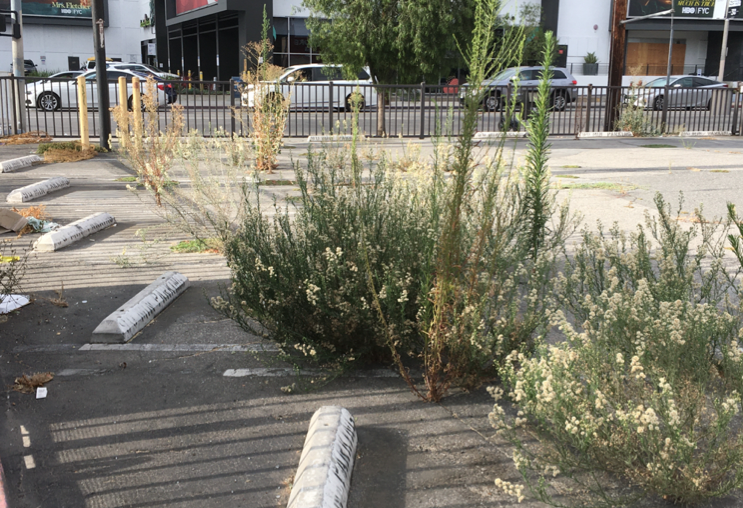CommentsPLANNING WATCH-Since its first baby steps in March 2020, the Covid-19 Pandemic and its deepening recession have taught us four important lessons.
Heyday for weeds. When stores shut down and landlords walk away from their properties, weeds quickly take over. The photo above shows what a few months of economic collapse looks like at a prime commercial corner on the westside of Los Angeles. (Third Street & LaCienega) Like viruses, these flowering weeds reveal that Mother Nature gets the last laugh in our economically fragile society. The former parking lot shown in the picture, like the store’s former employees, is doomed, even if the property eventually gets a trickle-down zone change.
Heyday for homelessness. In Los Angeles – like other cities -- homelessness has steadily increased since 2012. By early fall, Gary Blasi, a UCLA Emeritus Law School professor, forecasts 36,000 additional households becoming homeless.
Heyday for posting For Rent signs. If you print and sell For Rent signs, you might be one of the few people making money during this deep recession. Even before the current spike in Covid-19 cases, nearly ever apartment street is sprouting For Rent signs. Landlords are desperate to rent their vacant units since so many tenants have already moved out.
Death Knell to Supply-Side City Planning. For several decades neo-conservative economic nostrums have dominated academic and municipal City Planning Departments, buoyed by public officials from both major political parties. They not only drank gallons of trickle-down Kool-Aid but set up sidewalk stands to convince the public that real estate developers are ready to build affordable, transit-oriented housing. All they need is for cities and states to gut zoning and environmental laws, then “developers gone wild” will do the rest. Without regulations, their unleashed search for profits will cure a laundry list of social problems: increasing homelessness, declining transit ridership, and accelerating climate change.
But reality has forced these profiteers to beg for help. Staring into a deep recession that is quickly becoming another Great Depression, these faux free-marketeers are lining up with hat-in-hand. Like companies that were too big to fail in 2008-2010, they have miraculously seen the light. Wealthfare, recently expanded to include the Cares Act and other Federal stimulus packages, could save them from bankruptcy. They might welcome government deregulation, such as the Trump Administration’s recent decision to weaken federal NEPA environmental rules, but what they really pray for is billions to stuff into their corporate piggy banks. When their prayers are answered, they hope there will be enough bailout money left over to buy back corporate stock and raise their companies’ market valuations.

Let’s descend from this airplane view of Southern California to the ground, where diehard supply-siders still call for the Southern California Association of Government (SCAG) to impose upzoning on local cities through their Regional Housing Needs Assessment (RHNA). Despite any evidence, they fervently believe that if SCAG assigns cities a larger housing allocation, a residential building boom will ensue. But, even if local cities agreed to upzone themselves, it would not make the slightest difference. A closer look at this march of folly to solve the region’s housing crisis by harnessing greed explains why.
Their RHNA proposal rests on six fatal flaws:
Fatal Flaw #1) LA’s existing zoning allows the city to house 7,000,000 people WITHOUT ANY RHNA INCREASES. Chapter 7 of the General Plan Framework’s Draft Environmental Impact Report analyzed LA’s enormous residential zoning capacity in detail.
Fatal Flaw #2) LA’s two density bonus programs, SB 1818 and TOC Guidelines, raise LA's zoning buildout population to 9,000,000 people WITHOUT ANY RHNA INCREASES. The city’s population could double in size without any changes to existing zoning.
Fatal Flaw #3) LA’s aging and failing public services and infrastructure cannot support even a tiny fraction of these additional buildings and people, whether they obtain building permits through under-utilized existing zoning or from RHNA up-zoning. This is why LA’s existing level of development has resulted in broken and buckling streets and sidewalks, water mains that unpredictably burst, and frequent electrical blackouts.
Fatal Flaw #4) LA's population is static, and some demographers say is already shrinking. The city is falling apart at the seams, and it takes more than expensive housing with high vacancy rates to reverse this decline, especially when the Pandemic and recession force many Angelinos back to childhood bedrooms, overcrowded apartments, and empty store fronts.
Fatal Flaw #5) LA’s homeless population is still growing, and the crisis will get much worse for the foreseeable future. People are not homeless because there is housing shortage. Despite a tsunami of old and new vacancies, they are suddenly homeless because they have become poor, and they cannot afford to rent vacant expensive apartments and houses.
Fatal Flaw #6) Landlords creatively fill empty McMansions and unrented apartments through short-term rentals, like AirBnB, and/or for party houses. This keeps the cash flowing, even though it makes the housing crisis worse.
So far these city planning trickle-downers have ignored the painfully obvious. No matter how times they repeat their supply-and-demand mantra, it only works when investors turn a decent profit on speculative real estate projects. When the risk is too great, like the present, investors don’t care if LA’s unused zoning capacity sits idle or increases. It also explains why increases in SCAG’s Regional Housing Needs Assessment will not make the slightest difference. Whether LA consists of generous existing zoning or RHNA-imposed up-zoning, investors are wary of gambling away their capital on thousands of expensive residential units that will not sell or rent. Unless they reverse gears and enter the real estate business to lose money, boosting a city’s RHNA allocation will not persuade investors to part with their money. Unlike their tireless advocates, they realize no one can spark a real estate boom by “pushing an (economic) string.”
My conclusion is that the Pandemic and its deep recession demonstrate how irrelevant upzoning is to solving the housing crisis. In fact, it makes the housing crisis worse and also reduces transit ridership by locating high income, car-oriented tenants near mass transit in lieu of lower income, transit-oriented residents.
This is why the handwriting is on the wall for the city planning profession. It is time to forget about trickle-down fixes, like upzoning and environmental deregulation.
(Dick Platkin is a former Los Angeles city planner who reports on local planning issues for CityWatch. He serves on the board of United Neighborhoods for Los Angeles (UN4LA) and is co-chair of the new Greater Fairfax Residents Association. Please email comments and corrections to [email protected] or via Twitter to @DickPlatkin.
















